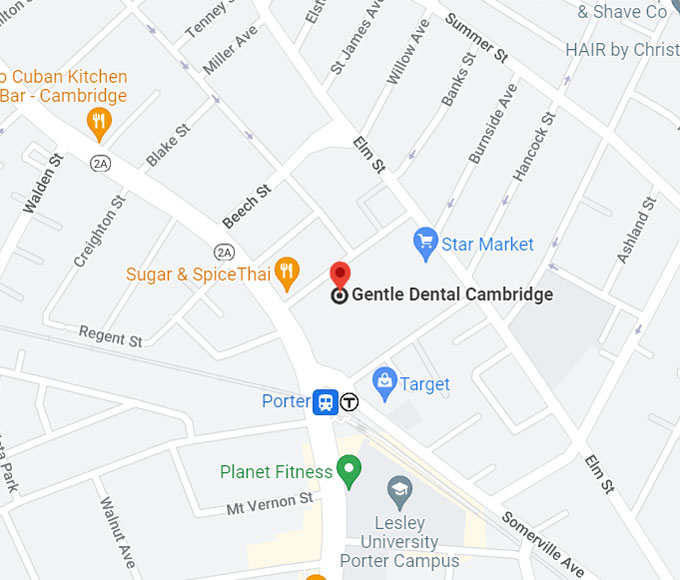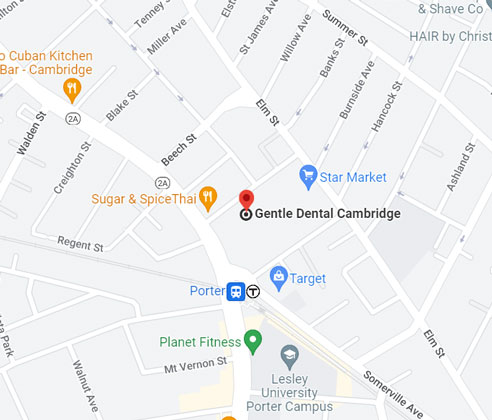- Locations
- Locations
- Arlington
- Attleboro
- Belmont
- Beverly
- Boston
- Braintree
- Brockton
- Brookline
- Burlington
- Cambridge
- Chelmsford
- Concord, NH
- Derry, NH
- East Longmeadow
- Exeter, NH
- Franklin
- Hanover
- Hudson
- Keene, NH
- Malden
- Manchester, NH
- Medford
- Methuen
- Milford
- Nashua, NH
- Natick
- New Bedford
- North Andover
- Norwood
- Peabody
- Quincy
- Raynham
- Rochester, NH
- Saugus
- Seekonk
- Somerville
- Stoughton
- Wakefield
- Waltham
- Worcester
- Dental Services

Teeth Whitening - Cambridge
Transform your smile in as few as one visit with teeth whitening in Cambridge, MA, to remove years of stains from coffee, tea, and tobacco, revealing the brighter, more confident smile you deserve.
Dental Office Hours
Monday 7:00 AM - 8:00 PM
Tuesday 7:00 AM - 8:00 PM
Wednesday 7:00 AM - 8:00 PM
Thursday 7:00 AM - 8:00 PM
Friday 7:00 AM - 5:00 PM
Saturday 9:00 AM - 5:00 PM
Sunday CLOSED
More Information
Located in the Porter Square Shopping Center. Free parking.
Now Welcoming Fresh Pond Dental patients!
Dental Office Hours
Monday 7:00 AM - 8:00 PM
Tuesday 7:00 AM - 8:00 PM
Wednesday 7:00 AM - 8:00 PM
Thursday 7:00 AM - 8:00 PM
Friday 7:00 AM - 5:00 PM
Saturday 9:00 AM - 5:00 PM
Sunday CLOSED
More Information
Located in the Porter Square Shopping Center. Free parking.
Now Welcoming Fresh Pond Dental patients!
Gentle Dental Cambridge Reviews
Today my temporary crown was replaced with the permane Mr. Went , exellent work, molar fits perfectly.
Came in for an emergency appointment. Dr Andrew was very helpful. He gave me his business card and told me to call/email him should my condition worsen, and that he will be there if I needed to see the ER. Place is very clean and modern. Reception staff are also very helpful and friendly. I have no gauge of the prices in the Cambridge area but I didn't have insurance and what I was charged was quite reasonable for what I needed to be treated for.
Dental Services in Cambridge
Beyond teeth whitening, our Cambridge, MA, office offers comprehensive dental services. From routine cleanings to advanced cosmetic treatments, we are here to address all your dental needs. Explore our other services today!
Preventive Care
Restorative Care
Crowns and Bridges
Dental Fillings
Extractions
Gum Treatments
Implants
Oral Surgery
Partial and Full Dentures
Root Canals
Wisdom Teeth Extractions
Orthodontics
Additional Services
What Is Teeth Whitening
Teeth whitening refers to various processes designed to make natural teeth appear brighter and whiter. Methods include sanding down stains, bleaching, ultraviolet (UV) light therapy, and more.
Many teeth whitening products are available; you can try several approaches at home. You can also opt for professional teeth whitening at your dentist's office in Cambridge.
However, some teeth-whitening methods can cause side effects, such as tooth sensitivity and gum irritation. Let's explore how teeth whitening works, how to do it safely, and what you should know about its potential side effects.
Different Types Of Tooth Stains
To effectively whiten your teeth, it's essential to choose a whitening method that targets the type of staining you have. If you have intrinsic and extrinsic stains (explained below), you'll likely need a whitening approach that safely addresses each type.
If you need help determining which stains affect your teeth, consult your dentist for teeth whitening in Cambridge. They can assess the kind of discoloration and recommend the most suitable treatment method.
Intrinsic stains
Intrinsic stains occur within the tooth enamel itself. These stains can form before your teeth even emerge as a child and may be caused by antibiotic use, excessive fluoride exposure, or the natural thinning of enamel with age. Intrinsic staining can also have a genetic component, as noted in a 2014 study.
Extrinsic stains
Extrinsic stains develop on the outer surface of the tooth. These are often caused by external factors like coffee, artificial food colorings, or smoking, which discolor the enamel. Like intrinsic stains, extrinsic stains can also be linked to antibiotic use, according to 2014 research.
Teeth Whitening Choices
Teeth whitening options range from whitening toothpaste to professional treatments performed by your dentist.
Some products remove extrinsic stains from the surface of your teeth, while others bleach both intrinsic and extrinsic stains to make them appear lighter.
Many over-the-counter and in-office treatments use hydrogen peroxide to break down and reduce stains. Carbamide peroxide, another joint whitening agent, is also frequently used.
These chemicals can be harsh and irritate in higher concentrations, so following the instructions when using teeth whitening products is crucial.
Whitening products
OTC whitening products, such as whitening toothpaste and mouthwash, often contain ingredients like baking soda, which acts as a gentle abrasive to help remove stains. Some whitening toothpastes also include charcoal, known for its abrasive properties. Additionally, these products may contain low concentrations of carbamide or hydrogen peroxide for whitening.
However, overusing abrasive substances can damage tooth enamel, the hard outer layer of teeth. Unlike other parts of the tooth, enamel doesn't regenerate because it isn't composed of living cells, as the American Dental Association (ADA) noted. It's essential to consult your dentist to use abrasive whitening products safely.
Many whitening products also include fluoride, which helps strengthen enamel and protect against future staining.
At-home whitening kits
Home whitening kits, come in various forms, such as gels or pastes applied to teeth with a brush or sticky strips that adhere to the surface.
Some kits involve applying a whitening agent and placing a mouthguard over your teeth. Specific kits include heat lamps, blue light, or UV light within the mouthguard to "activate" the whitening paste. However, a small 2021 study suggests it needs to be clarified if these lights enhance the gel's effectiveness.
The mouthguard helps keep the bleaching agent on your teeth, improving absorption and limiting contact with your gums. According to 2019 research, the ADA has approved gel with 10% carbamide for overnight use in at-home mouthguards.
At-home whitening kits contain lower concentrations of active ingredients than those used in a dentist's office, meaning you must use them daily for several weeks to see results. Most at-home kits promise visible improvements within 2 to 4 weeks.
Possible Side Effects Of Teeth Whitening
The most common side effect of teeth whitening is temporary tooth sensitivity, and mouth or gum irritation is also frequently reported. Hydrogen peroxide, in particular, can trigger this reaction.
Dentists protect the gum tissue during teeth whitening to minimize irritation. However, with professional treatments and at-home kits, you may still experience increased sensitivity to hot or cold foods and drinks. This sensitivity can also feel like a sudden, sharp pain in your teeth, but it is usually temporary.
According to 2019 research, overusing teeth whitening products or undergoing frequent whitening sessions can result in permanent enamel damage, so it's important to follow recommended guidelines for safe use.
Who Is A Good Candidate For Teeth Whitening?
A good candidate for teeth whitening is someone with healthy tooth enamel and no untreated dental issues, such as cavities or gum disease. People with discoloration from aging, food, drinks like coffee or tea, smoking, or medications are ideal candidates. Those with yellow or orange stains typically see the best results from whitening treatments. However, individuals with intrinsic stains, sensitive teeth, or thinning enamel should consult their dentist before starting a teeth whitening regimen to ensure it's safe and effective for their needs.
Top Commercial Teeth Whitening Products
Teeth Whitening Strips
Teeth whitening strips offer an affordable way to brighten your smile at home. These strips are coated with a professional-grade whitening gel applied directly to your teeth and worn for a set time each day. However, because these treatments don't customize your smile, they may lead to uneven whitening or discomfort. If you consider teeth whitening in Cambridge, professional treatment options provide more tailored and effective results.
Teeth Whitening Toothpaste
Teeth whitening toothpaste is a more gentle and budget-friendly option for achieving a brighter smile, making it a good choice for maintaining professional teeth whitening results in Cambridge. With unique ingredients, whitening toothpaste helps remove surface stains and prevent new ones from forming, though it may take longer to achieve noticeable results compared to other whitening methods.
Teeth Whitening Vs. Teeth Bleaching: What's The Difference?
Teeth Whitening
Teeth whitening in Cambridge focuses on removing surface stains and buildup that can cause teeth to appear yellow or brown. The term "whitening" is often used for any product that brightens your smile by cleaning the teeth, including whitening toothpaste.
Teeth Bleaching
Teeth bleaching refers to using products that whiten teeth beyond their natural shade. Often used in teeth whitening, these products contain powerful bleaching agents like hydrogen or carbamide peroxide to achieve a brighter, more radiant smile.
Frequently Asked Questions
How can I effectively whiten my teeth?
Gentle Dental Cambridge offers dental services, including professional teeth whitening, to help you achieve a brighter, healthier smile. Our treatments effectively remove stains and discoloration, giving long-lasting results in a comfortable, stress-free environment.
Is teeth whitening a safe procedure?
Yes, teeth whitening is generally safe when done under the guidance of a dental professional. At Gentle Dental, our teeth whitening services use professional-strength whitening agents that are both safe and effective.
However, teeth whitening may not be suitable for everyone. If you have cavities or gum disease, your Gentle Dental dentist should address these issues before whitening. Typically, your dentist will conduct an oral exam to ensure teeth whitening is appropriate for your dental health.
A possible side effect is gum irritation if the whitening gel comes into contact with the gums. Fortunately, our experienced team takes extra care during the whitening process, using protective measures to safeguard your gums and reduce the risk of inflammation.
How long do the effects of teeth whitening last?
The longevity of teeth whitening results depends on factors such as your diet, tobacco use, and oral hygiene habits. With proper care and maintenance, the effects of teeth whitening from Gentle Dental Cambridge can last up to two years.
Can teeth whitening harm my enamel?
When done correctly, teeth whitening does not harm enamel. At Gentle Dental Cambridge, trained professionals conduct our teeth whitening services and take extra precautions to protect your enamel and minimize potential sensitivity. For those seeking professional care, teeth whitening in Cambridge, MA, offers a safe and effective way to brighten your smile.
Is it possible to whiten my teeth if I have sensitive teeth?
Yes, you can whiten your teeth even if you have sensitive teeth. Gentle Dental Cambridge offers professional-strength whitening agents specifically formulated to minimize sensitivity and discomfort. Your dentist may also recommend using a desensitizing paste to provide extra relief.
How can I preserve my teeth whitening results?
Maintaining good oral hygiene, limiting your intake of stain-causing foods and beverages, and scheduling regular check-ups and cleanings with your dentist at Gentle Dental Cambridge are essential. Additionally, using an at-home touch-up kit can help prolong the effects of your bright smile.
Book an Appointment
If your request is a dental emergency, or you would like to call and schedule your dental appointment, contact information for our offices can be found here: Gentle Dental Locations. New patient offer not valid for emergency appointments.

